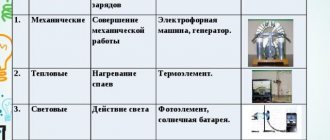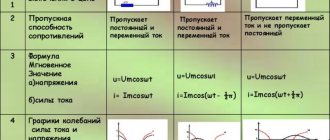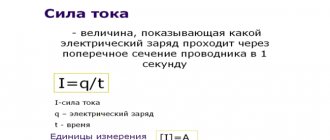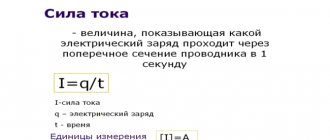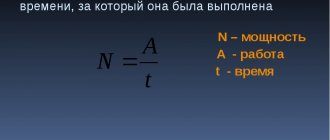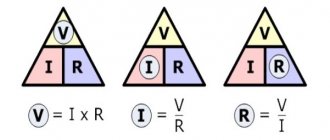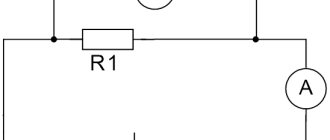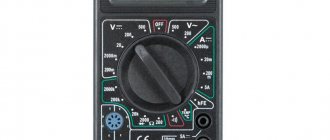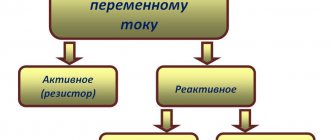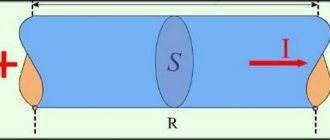Electricity - directed (ordered) movement of particles, electric charge carriers, in an electromagnetic field.
What is electric current in different substances? Let us take, accordingly, moving particles:
- in metals - electrons,
- in electrolytes - ions (cations and anions),
- in gases - ions and electrons,
- in a vacuum under certain conditions - electrons,
- in semiconductors - holes (electron-hole conductivity).
Sometimes electric current is also called displacement current, which arises as a result of a change in the electric field over time.
Electric current manifests itself as follows:
- heats conductors (the phenomenon is not observed in superconductors);
- changes the chemical composition of the conductor (this phenomenon is primarily characteristic of electrolytes);
- creates a magnetic field (manifests itself in all conductors without exception).
Classification
Direct and alternating current
If charged particles move inside macroscopic bodies relative to a particular medium, then such a current is called electric “conduction current”. If macroscopic charged bodies (for example, charged raindrops) are moving, then this current is called “convection”.
Currents are divided into direct and alternating. There are also all kinds of alternating current. When defining types of current, the word “electric” is omitted.
- Direct current is a current whose direction and magnitude do not change over time. There can be a pulsating, for example a rectified variable, which is unidirectional.
- Alternating current is an electric current that varies over time. Alternating current refers to any current that is not direct.
- Periodic current is an electric current, the instantaneous values of which are repeated at regular intervals in an unchanged sequence.
- Sinusoidal current is a periodic electric current that is a sinusoidal function of time. Among alternating currents, the main one is the current whose value varies according to a sinusoidal law. Any periodic non-sinusoidal current can be represented as a combination of sinusoidal harmonic components (harmonics) having corresponding amplitudes, frequencies and initial phases. In this case, the electrostatic potential of each end of the conductor changes in relation to the potential of the other end of the conductor alternately from positive to negative and vice versa, passing through all intermediate potentials (including zero potential). As a result, a current arises that continuously changes direction: when moving in one direction, it increases, reaching a maximum, called the amplitude value, then decreases, at some point becomes equal to zero, then increases again, but in a different direction and also reaches the maximum value , decreases and then passes through zero again, after which the cycle of all changes resumes.
- Quasi-stationary current is a relatively slowly varying alternating current, for instantaneous values of which the laws of direct currents are satisfied with sufficient accuracy. These laws are Ohm's law, Kirchhoff's rules and others. Quasi-stationary current, like direct current, has the same current strength in all sections of an unbranched circuit. When calculating quasi-stationary current circuits due to the emerging e. d.s. inductions of capacitance and inductance are taken into account as lumped parameters. Ordinary industrial currents are quasi-stationary, except for currents in long-distance transmission lines, in which the condition of quasi-stationary along the line is not satisfied.
- High-frequency current is an alternating current (starting from a frequency of approximately tens of kHz), for which such phenomena become significant that are either useful, determining its use, or harmful, against which the necessary measures are taken, such as radiation of electromagnetic waves and skin effect . In addition, if the wavelength of alternating current radiation becomes comparable to the dimensions of the elements of the electrical circuit, then the quasi-stationary condition is violated, which requires special approaches to the calculation and design of such circuits.
- A pulsating current is a periodic electric current, the average value of which over a period is different from zero.
- Unidirectional current is an electric current that does not change its direction.
Eddy currents
Eddy currents Foucault
Eddy currents (or Foucault currents) are closed electric currents in a massive conductor that arise when the magnetic flux penetrating it changes, therefore eddy currents are induced currents. The faster the magnetic flux changes, the stronger the eddy currents. Eddy currents do not flow along specific paths in wires, but when they close in the conductor, they form vortex-like circuits.
The existence of eddy currents leads to the skin effect, that is, to the fact that alternating electric current and magnetic flux propagate mainly in the surface layer of the conductor. Heating of conductors by eddy currents leads to energy losses, especially in the cores of AC coils. To reduce energy losses due to eddy currents, they use the division of alternating current magnetic circuits into separate plates, isolated from each other and located perpendicular to the direction of the eddy currents, which limits the possible contours of their paths and greatly reduces the magnitude of these currents. At very high frequencies, instead of ferromagnets, magnetodielectrics are used for magnetic circuits, in which, due to the very high resistance, eddy currents practically do not arise.
Characteristics
Historically, it was accepted that the “direction of current” coincides with the direction of movement of positive charges in the conductor. Moreover, if the only current carriers are negatively charged particles (for example, electrons in a metal), then the direction of the current is opposite to the direction of movement of the charged particles.
Drift speed of electrons
The drift speed of the directional movement of particles in conductors caused by an external field depends on the material of the conductor, the mass and charge of the particles, the surrounding temperature, the applied potential difference and is much less than the speed of light. In 1 second, electrons in a conductor move due to ordered motion by less than 0.1 mm. Despite this, the speed of propagation of the electric current itself is equal to the speed of light (the speed of propagation of the electromagnetic wave front). That is, the place where the electrons change the speed of their movement after a change in voltage moves with the speed of propagation of electromagnetic oscillations.
Current strength and density
Electric current
Electric current has quantitative characteristics: scalar - current strength, and vector - current density.
Current strength a is a physical quantity equal to the ratio of the amount of charge
, which has passed for some time
through the cross section of the conductor, to the value of this period of time.
Current strength in SI is measured in amperes (international and Russian designation: A).
According to Ohm's law, the current strength
in a section of the circuit is directly proportional to the electrical voltage
, applied to this section of the circuit, and is inversely proportional to its resistance
.
If the electric current in a section of the circuit is not constant, then the voltage and current are constantly changing, while for ordinary alternating current the average values of voltage and current are zero. However, the average power of heat released in this case is not equal to zero.
Therefore, the following concepts are used:
- instantaneous voltage and current, that is, acting at a given moment in time.
- amplitude voltage and current, that is, maximum absolute values
- effective (effective) voltage and current are determined by the thermal effect of the current, that is, they have the same values that they have for direct current with the same thermal effect.
Current density is a vector, the absolute value of which is equal to the ratio of the strength of the current flowing through a certain section of the conductor, perpendicular to the direction of the current, to the area of this section, and the direction of the vector coincides with the direction of movement of the positive charges forming the current.
According to Ohm's law in differential form, the current density in the medium
proportional to the electric field strength
and medium conductivity
.
Power
When there is current in a conductor, work is done against resistance forces. The electrical resistance of any conductor consists of two components:
- active resistance - resistance to heat generation;
- reactance - resistance caused by the transfer of energy to an electric or magnetic field (and vice versa).
Typically, most of the work done by an electric current is released as heat. The heat loss power is a value equal to the amount of heat released per unit time. According to the Joule-Lenz law, the power of heat loss in a conductor is proportional to the strength of the flowing current and the applied voltage:
Power is measured in watts.
In a continuous medium, volumetric loss power
is determined by the scalar product of the current density vector
and electric field strength vector
at this point:
Volumetric power is measured in watts per cubic meter.
Radiation resistance is caused by the formation of electromagnetic waves around a conductor. This resistance is complexly dependent on the shape and size of the conductor, and on the length of the emitted wave. For a single straight conductor, in which everywhere the current is of the same direction and strength, and the length L of which is significantly less than the length of the electromagnetic wave emitted by it
, the dependence of resistance on wavelength and conductor is relatively simple:
The most commonly used electric current with a standard frequency of 50 Hz corresponds to a wave length of about 6 thousand kilometers, which is why the radiation power is usually negligible compared to the power of thermal losses. However, as the frequency of the current increases, the length of the emitted wave decreases, and the radiation power increases accordingly. A conductor capable of emitting noticeable energy is called an antenna.
Frequency
The concept of frequency refers to an alternating current that periodically changes strength and/or direction. This also includes the most commonly used current, which varies according to a sinusoidal law.
The AC period is the shortest period of time (expressed in seconds) through which changes in current (and voltage) repeat. The number of periods performed by current per unit time is called frequency. Frequency is measured in hertz, one hertz (Hz) equals one cycle per second.
Bias current
Sometimes, for convenience, the concept of displacement current is introduced. In Maxwell's equations, the displacement current is present on equal terms with the current caused by the movement of charges. The intensity of the magnetic field depends on the total electric current, equal to the sum of the conduction current and the displacement current. By definition, the bias current density
is a vector quantity proportional to the rate of change of the electric field
in time:
The fact is that when the electric field changes, as well as when current flows, a magnetic field is generated, which makes these two processes similar to each other. In addition, a change in the electric field is usually accompanied by a transfer of energy. For example, when charging and discharging a capacitor, despite the fact that there is no movement of charged particles between its plates, they speak of a displacement current flowing through it, transferring some energy and closing the electrical circuit in a unique way. Bias current
in a capacitor is determined by the formula:
,
Where
- charge on the capacitor plates,
- electrical voltage between the plates,
- electrical capacitance of the capacitor.
Displacement current is not an electric current because it is not associated with the movement of an electric charge.
Current unit
Now imagine very thin and very long conductors. They are located parallel to each other. The distance between them is $1 \space m$. The current strength in them is the same. And all this in a vacuum! This is where the unit of current measurement comes in (Figure 3).
As a unit of current strength, I take the current strength at which segments of parallel conductors of length $1 \space m$ interact with a force of $2 \cdot 10^{-7} \space Н$ ($0.0000002 \space Н$).
Figure 3. Defining the unit of current measurement
The name of this unit is ampere ($A$) . It is named after the French physicist Andre Ampère (Figure 4).
Figure 4. Ampere Andre Marie (1775 - 1836) - French physicist, mathematician and natural scientist. He introduced the concept of electric current into physics, for which he was nicknamed “the Newton of electricity” in the scientific community.
Main types of conductors
Unlike dielectrics, conductors contain free carriers of uncompensated charges, which, under the influence of a force, usually an electrical potential difference, move and create an electric current. The current-voltage characteristic (the dependence of current on voltage) is the most important characteristic of a conductor. For metal conductors and electrolytes, it has the simplest form: the current strength is directly proportional to the voltage (Ohm's law).
Metals - here the current carriers are conduction electrons, which are usually considered as an electron gas that clearly exhibits the quantum properties of a degenerate gas.
Plasma is an ionized gas. Electric charge is transferred by ions (positive and negative) and free electrons, which are formed under the influence of radiation (ultraviolet, x-ray and others) and (or) heating.
Electrolytes are liquid or solid substances and systems in which ions are present in any noticeable concentration, causing the passage of electric current. Ions are formed through the process of electrolytic dissociation. When heated, the resistance of electrolytes decreases due to an increase in the number of molecules decomposed into ions. As a result of the passage of current through the electrolyte, ions approach the electrodes and are neutralized, settling on them. Faraday's laws of electrolysis determine the mass of a substance released on the electrodes.
There is also an electric current of electrons in a vacuum, which is used in electron beam devices.
Conductor/circuit resistance.
The term “resistance” actually speaks for itself) So, resistance is a physical quantity that characterizes the properties of a conductor to impede (resist) the passage of electric current.
Consider a copper conductor of length l with a cross-sectional area equal to S:
Conductor resistance depends on several factors:
- conductor resistivity \rho
- conductor length l
- conductor cross-sectional area S
Resistivity is a tabular value. The formula with which you can calculate the resistance of a given conductor is as follows:
R = \rho\medspace \frac{l}{S}
For our case, \rho will be equal to 0.0175 (Ohm * sq. mm / m) - the resistivity of copper. Let the length of the conductor be 0.5 m and the cross-sectional area be 0.2 sq. mm. Then:
R =0.0175\cdot\frac{0.5}{0.2} = 0.04375\medspace Ohm
And, as you already understood from the example, the unit of measurement for resistance is Ohm. Let's consider the relationship between voltage, current and circuit resistance.
Electric currents in nature
Lightning
Atmospheric electricity is electricity that is contained in the air. Benjamin Franklin was the first to show the presence of electricity in the air and explain the cause of thunder and lightning.
It was subsequently found that electricity accumulates in the condensation of vapors in the upper atmosphere, and the following laws were indicated that atmospheric electricity follows:
- in a clear sky, as well as in a cloudy sky, the electricity of the atmosphere is always positive, unless it rains, hails or snows at some distance from the observation site;
- the voltage of cloud electricity becomes strong enough to be released from the environment only when cloud vapors condense into raindrops, evidence of which can be seen in the fact that lightning discharges do not occur without rain, snow or hail at the observation site, excluding a return lightning strike;
- atmospheric electricity increases as humidity increases and reaches a maximum when rain, hail and snow fall;
- the place where it rains is a reservoir of positive electricity, surrounded by a belt of negative, which in turn is enclosed in a belt of positive. At the boundaries of these belts the stress is zero.
The movement of ions under the influence of electric field forces forms a vertical conduction current in the atmosphere with an average density equal to about (2÷3) 10−12 A/m².
The total current flowing over the entire surface of the Earth is approximately 1800 A.
Lightning is a natural sparking electrical discharge. The electrical nature of the auroras was established. St. Elmo's Fire is a natural corona electrical discharge.
Biocurrents - the movement of ions and electrons plays a very significant role in all life processes. The biopotential created in this way exists both at the intracellular level and in individual parts of the body and organs. The transmission of nerve impulses occurs using electrochemical signals. Some animals (electric stingrays, electric eels) are capable of accumulating potentials of several hundred volts and use this for self-defense.
Application
When studying electric current, many of its properties were discovered, which made it possible to find practical application in various areas of human activity, and even to create new areas that would have been impossible without the existence of electric current. After practical application was found for electric current, and for the reason that electric current can be obtained in various ways, a new concept arose in the industrial sphere - electric power.
Electric current is used as a carrier of signals of varying complexity and types in different areas (telephone, radio, control panel, door lock button, and so on).
In some cases, unwanted electrical currents appear, such as stray currents or short circuit currents.
Use of electric current as an energy carrier
- obtaining mechanical energy in all kinds of electric motors,
- obtaining thermal energy in heating devices, electric furnaces, during electric welding,
- obtaining light energy in lighting and signaling devices,
- excitation of electromagnetic oscillations of high frequency, ultrahigh frequency and radio waves,
- receiving sound,
- obtaining various substances by electrolysis, charging electric batteries. Here electromagnetic energy is converted into chemical energy,
- creating a magnetic field (in electromagnets).
Use of electric current in medicine
Electrophoresis
- diagnostics - the biocurrents of healthy and diseased organs are different, and it is possible to determine the disease, its causes and prescribe treatment. The branch of physiology that studies electrical phenomena in the body is called electrophysiology. Electroencephalography is a method for studying the functional state of the brain.
- Electrocardiography is a technique for recording and studying electric fields during heart activity.
- Electrogastrography is a method for studying the motor activity of the stomach.
- Electromyography is a method for studying bioelectric potentials arising in skeletal muscles.
electrical safety
Warning on electrical safety
Includes legal, socio-economic, organizational and technical, sanitary and hygienic, treatment and preventive, rehabilitation and other measures. Electrical safety rules are regulated by legal and technical documents, regulatory and technical framework. Knowledge of the basics of electrical safety is mandatory for personnel servicing electrical installations and electrical equipment. The human body is a conductor of electric current. Human resistance with dry and intact skin ranges from 3 to 100 kOhm.
A current passed through a human or animal body produces the following effects:
- thermal (burns, heating and damage to blood vessels);
- electrolytic (decomposition of blood, disruption of physical and chemical composition);
- biological (irritation and excitation of body tissues, convulsions)
- mechanical (rupture of blood vessels under the influence of steam pressure obtained by heating by the blood flow)
The main factor determining the outcome of electric shock is the amount of current passing through the human body. According to safety precautions, electric current is classified as follows:
- “safe” is considered to be a current whose long-term passage through the human body does not cause harm to it and does not cause any sensations; its value does not exceed 50 μA (alternating current 50 Hz) and 100 μA direct current;
- The “minimum perceptible” alternating current for humans is about 0.6–1.5 mA (alternating current 50 Hz) and 5–7 mA for direct current;
- threshold “non-releasing” is the minimum current of such strength that a person is no longer able to tear his hands away from the current-carrying part by force of will. For alternating current this is about 10-15 mA, for direct current - 50-80 mA;
- The “fibrillation threshold” is an alternating current (50 Hz) strength of about 100 mA and a direct current of 300 mA, the impact of which for more than 0.5 s is likely to cause fibrillation of the heart muscles. This threshold is also considered conditionally fatal for humans.
In Russia, in accordance with the Rules for the technical operation of electrical installations of consumers (Order of the Ministry of Energy of the Russian Federation dated January 13, 2003 No. 6 “On approval of the Rules for the technical operation of electrical installations of consumers”) and the Rules for labor protection during the operation of electrical installations (Order of the Ministry of Energy of the Russian Federation dated December 27, 2000 N 163 “On approval of Interindustry Rules on Labor Protection (Safety Rules) for the Operation of Electrical Installations"), 5 qualification groups for electrical safety were established depending on the qualifications and experience of the employee and the voltage of electrical installations.
Current strength of some electrical appliances
For a better understanding of how much one ampere is in practice, Table 1 shows the average current values for some electrical appliances.
| Device | Current value $I$, A |
| Flashlight bulb | 0,1 |
| Regular incandescent lamp | 0,3 — 0,5 |
| Fridge | 0,8 — 1 |
| TV | 1,2 — 2 |
| Electric iron | 3 |
| Vacuum cleaner | 4 — 9 |
| Washing machine | 6 — 10 |
| Trolleybus engine | 160 — 220 |
| Lightning | more than 400,000 |
Table 1. Current values in various electricity consumers
